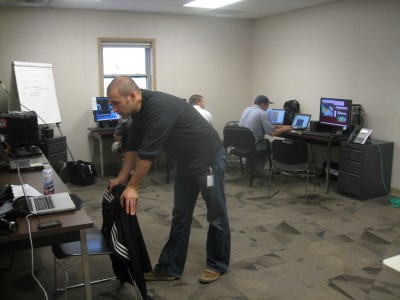A Day in the Life of an MC3E Student Forecaster
Published: 20 May 2011
When my adviser, Ed Zipser, suggested that I spend at least two weeks in Oklahoma forecasting for MC3E, I wasn’t quite sure what to expect. I have participated in several field programs, but never in the role of forecaster. I lived in Oklahoma for four years while I completed my bachelor’s degree at OU, but it’s been a long time since I’ve seen the types of weather that we hope for during MC3E. Fortunately, I have found that remembering how to forecast severe weather has come back quickly.

I’ve been helping out with the campaign since May 4. For any given day, there are 3 assigned forecasters, who are scheduled by our fearless leader, Scott Giangrande. The lead forecaster is in charge of giving the daily weather briefing. A “rover” forecaster provides an afternoon update and fills in for the lead forecaster if necessary. The “event” forecaster is typically on call and helps with “nowcasting” during events. Nowcasting is my favorite thing—it involves watching current conditions, especially radar. If any dangerous storms approach areas where we have people or equipment deployed for the project, the event forecaster must sound the alarm. Occasionally if we think that it will be raining at a sounding site during the scheduled launch time, we will call that site and request an earlier launch. Sounding data isn’t as useful once it starts raining—we want to get a profile of the atmosphere before the storm arrives.
Generally our day starts at 7 am, when we get up and have breakfast at the hotel. The lead forecaster gets up as early as 5 am to begin putting together the weather briefing. By 8:30 am all of the forecasters are seated around a table in a conference room at the Ponca City airport to call the National Weather Service (NWS) office in Norman, Oklahoma. The lead forecaster makes this call and asks questions about the evolution and timing of upcoming events. Many of the products and models that the NWS uses to forecast are available online, but the NWS forecasters in Norman have day-to-day experience and an excellent knowledge of weather patterns in Oklahoma. Their ideas are invaluable and play a major role in the forecast. The daily weather briefing happens at 9 am, and scientists from all over the country call in to the teleconference. The lead forecaster presents the forecast for Day 0 (today), Day 1 (tomorrow), Day 2 (day after tomorrow), and the extended forecast. These calls are pretty short if the forecast is sunny. If there is precipitation in the forecast, the call can last for up to an hour.
If the mission scientist decides that the forecast is worthy of flying, we settle on a time for the planes to take off. We have to give 24-hour notice, so understanding the forecast for the next few days is very important. The forecasters leave Ponca City at least 2 hours before the planned flight time and drive to the ARM Southern Great Plains Central Facility. We sit in the radar operations room and monitor the situation. The mission scientists coordinate with Jan Nystrom, who communicates with the planes. His knowledge of the aircraft and manner in dealing with air traffic control is impressive. Listening to the radio communications and watching the mission scientists plan the flight path is one of the most exciting parts of forecasting. During flights, the forecasters on duty keep an eye on NPOL and the locations where we launch soundings. We also answer any questions the mission scientists have about the thunderstorms, which could be anything from where development seems likely to occur to how high the storms extend into the atmosphere.
Flights typically last 5-6 hours, depending on the type of mission. After both planes are safely on the ground, the forecasters leave the Central Facility and head back to Ponca City. We have had a few overnight missions, and after these everybody is very glad to get back to the hotel and take a nap prior to the 9 am weather briefing. The people at the front desk frequently ask about the weather, and they seem to think that we are crazy when we say, “Oh, the weather is going to be great! It’s going to storm for the next three days!”
Forecasting during long periods of precipitation and thunderstorms can be pretty exhausting, but being in the center of a field project and helping make decisions that will affect the collection of data that will influence the science of measuring and modeling precipitation for years to come is pretty incredible.
Submitted by Christy Wall, MC3E student forecaster, University of Utah.
The ARM Climate Research Facility is a DOE Office of Science user facility. The ARM Facility is operated by nine DOE national laboratories, including .
Keep up with the Atmospheric Observer
Updates on ARM news, events, and opportunities delivered to your inbox
ARM User Profile
ARM welcomes users from all institutions and nations. A free ARM user account is needed to access ARM data.


















